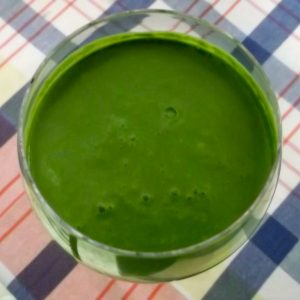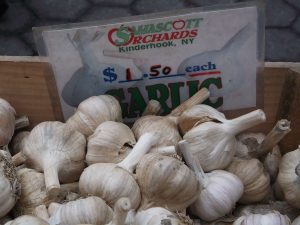Does eating raw garlic for breakfast make you shudder—or salivate?
For me, it’s the latter: I love a raw garlic “high” first thing in the morning!
It wasn’t long ago that, upon awakening, I groped my way to mental clarity with a triple espresso (dark, organic French roast was my favorite) brewed in an Italian moka pot. That was then! Mornings, now (entirely free of caffeine-fueled beverages), are when I find myself eagerly anticipating my “savory smoothie”—a green smoothie that includes 3 to 5 raw garlic cloves—as the first part of my breakfast.
My craving for raw garlic—and other sulfur-rich allium vegetables—intensified over the spring as I detailed in my previous post. Nicknamed the stinking rose, garlic has many lauded medicinal properties—any or all of which my body could be seeking—it’s an anti-viral, a natural antibiotic, an antioxidant and contains anti-cancer properties. Regardless of why my body demands so much garlic, it’s the star ingredient in my smoothie.
Raw garlic can be potent. It can be hot. It can have an aggressive bite. But, I promise you: in this smoothie, its abrasive sting softens and blends beautifully in an elixir of leafy greens, spices, sea salt, avocado and coconut oil. My husband loves this smoothie and drinks it with the same reverence that he reserves for a show-stopping Bordeaux.
Spend a few extra cents and buy locally grown or organic garlic. In my experience, I’ve found supermarket garlic sadly inferior. Too often, I’ve had to throw out as much as half a head of supermarket garlic because the cloves were brown, mottled, soft, moldy or sprouting shoots. Who knows how long it’s been sitting on the shelf—or where it’s from? Interestingly, the U.S. is the world’s largest import market for fresh garlic—and the majority the garlic we import is from China. I won’t buy garlic from China, a country halfway around the world, rife with environmental pollution and questionable practices re: food safety, quality and pesticide use.
So, I willingly spend $1.50 for a head of garlic at the farmers’ market or buy organic garlic at my health food store. And I’m rewarded with firm, plump, white cloves that impart an assertive bite as truly fresh garlic should.
After being diagnosed with Stage 3 adrenal fatigue earlier this year, I have found this smoothie—with its particular combination of fiber, protein, fat and spices—delicious, filling and effective in stabilizing blood sugar. When I finish blending it in my Nutribullet, I pour it into a wine glass and savor every verdant sip. It gives me a marked energy boost—and effectively promotes elimination and detoxification.
Are you grappling with candida? There is no fruit sweetness in this smoothie–other than lime. If you’re able to tolerate raw garlic—add 2 cloves (working your way up to four cloves) to this smoothie. Garlic is a powerful anti-fungal that can help inhibit candida overgrowth.
When it comes to eating raw leafy greens, some advice: Try—whenever possible—to buy organic. Conventionally grown leafy greens, including spinach, kale and collard greens, are on the Environmental Working Group’s “Dirty Dozen Plus” list: they contain pesticide residues, like organophosphates, that cannot be washed out. Also: be sure to rotate your greens. I love spinach, but because it is high in oxalates, a naturally occurring substance found in many plants, I am careful not eat spinach on a daily basis. Some other oxalate-dense greens include Swiss chard, beet greens and collard greens. Oxalates protect plants from predators, forming oxalate crystals that can rip the teeth of insects attempting to eat them. The human body also contain oxalates, and our cells will convert certain substances—such as Vitamin C (ascorbic acid taken in high doses) or high levels of fructose—into oxalates. Dietary oxalate restriction is recommended for those with hyperoxaluria (high levels of oxalates in the urine) or kidney stones. High oxalate foods can also be an issue if you’re dealing with leaky gut or other digestive issues.
I enjoy a variation of this smoothie most days, and I haven’t had an issue with oxalates. But they can be a controversial topic in the nutrition world. Just remember: more is not necessarily better! Be prudent and moderate your consumption of raw, high oxalate greens.
Savory Smoothie
6 cups of organic romaine, mixed baby greens, baby spinach, mesclun
mix, or other organic leafy green of choice
2 tablespoons organic whole flaxseed, then ground
1/2 teaspoon Celtic sea salt
1/2 teaspoon ground nutmeg
2 teaspoons ground cinnamon
2 teaspoons ground turmeric
2 teaspoons coconut oil
2 slices of avocado, cubed
3 to 5 cloves of organic or locally grown garlic
Juice of 1 large lime
1-1/2 cups of filtered water
Blend all ingredients until well combined in a Nutribullet or Vitamix. Pour into a wine glass. Enjoy!



